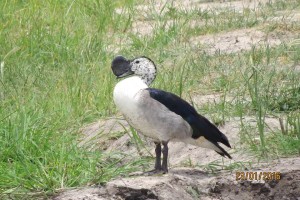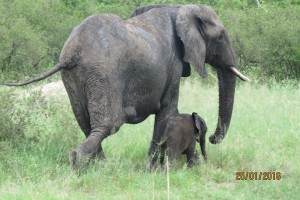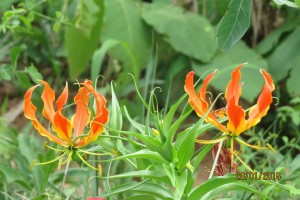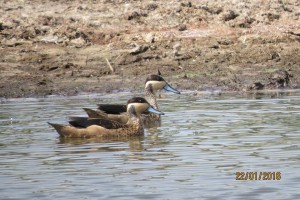
Image J Brebner
We have just had a phenomenal birding trip up to Hwange for a week, mainly to conduct the African Waterfowl Census which is carried out each January and July. During our time in the park, we managed to record 222 bird species! It is a wonderful time to study the migrant birds in the park, particularly the various raptors. We saw countless European rollers but the other rollers were out in numbers too as were the bee eaters, with plenty of juvenile carmine bee eaters flitting about. Although most of the places we traveled have had some rain showers and in a few areas the bush is thick and lush looking, it is obvious that rain generally has been sparse and patchy. January is usually a glorious time in the park, especially if there has been abundant rainfall and the natural water pans are full. They host a myriad of waterbirds and sometimes the puddles in the road may even have a paddling duck or two. Not so this year, sadly. All the people we spoke to who are involved in some way in the park commented on the poor rains so far this year.

Image J Brebner
We started off with two nights at Sinamatella and once we’d settled into our lodge, we took off for a drive to begin our waterfowl counting. Initially we didn’t see much and water along the vlei was pretty sparse. But close to the Mandavu turn off, we stopped to admire a male knob billed duck that had waddled out of the grass at the side of the road when, looking down, we spotted two cheetah heads peering out of the long grass! Unfortunately, these lovely creatures didn’t stick around to be admired when we tried to get a better view. We stopped off briefly at the Mandavu picnic site below the wall and watched an osprey quartering the dam. It dropped at speed with a rather ungainly splash down into the water, then emerged with a fairly large fish in its talons.

Image J Brebner
We spent the whole of the next day in the Robins Camp area starting off at a fairly dry Salt Pan. On our way there, we came across a spotted hyena peering round a bush at the side of the road. It gave us a baleful glare, then scampered across to road and slunk off into the bush. While there were plenty of waterbirds to count at Salt Pan, numbers were low compared to previous years and because of the small body of water, it was easy to count the far side through the spotting scopes without having to move around and disturb the birds. There were plenty of small waders that kept us busy but very few pratincoles this year – we only saw about five or six – and only two avocets. We moved on to Deteema Dam and spent a few happy hours in the Mike Edwards hide. There were plenty of Egyptian geese on the dam – almost outnumbering the blacksmith lapwings! Here again, the dam was quite low for the time of the year so it became difficult at times to identify the various waterfowl dabbling around in the long grass and water weed sticking up out of the muddy flats. On our way back to Sinamatella, we stopped off at the Mandavu camp site. While there we spotted an unusual large tern-like looking bird harassing flocks of white winged and whiskered terns and eventually managed to identify it as a Caspian tern which caused great excitement. Although it landed a long way off, we did manage to get a passable photo of it to prove its existence! During our entire time in the park, there were always brown or black blobs flying high or low, and many trees festooned with kites, lesser spotted eagles, tawnys, steppe eagles and buzzards. We are sure there were some unusuals amongst them but some of those raptors are difficult to identify. Vultures, too, were very visible and we saw plenty including some very handsome white headed ones. There were several occasions during the trip when swarms of flying ants emerged in their thousands from the ground. A spectacular aerial display ensued with birds of all sizes and shapes, swooping and swirling to catch the insects on the wing. Others, particularly the abdim and woolly necked storks, the hornbills, starlings and hooded vultures, darted around the veld and along the roads picking up their share of the feast.

Image J Brebner
On our way through the park to Main Camp, we monitored all the pans we came across and we were once again saddened by the lack of water. Shumba is looking great and holding good water thanks to the two solar units there, but Dwarf Goose pan was just a muddy puddle. Besides three blacksmith lapwings, three spurwinged geese and a lone jacana, there wasn’t anything else to be seen there. Water along the sides of the road was very sparse and several of the natural pans were dry. Arriving at Nyamandhlovu, we caught a huge herd of buffalo just walking off after a drink, and watched an enormous, gnarled old daggaboy having a rather ungainly roll in a muddy depression. There was plenty of other game around – zebra, kudu, impala, two roan and four waterbuck, two of which were young rams engaged in a tussle. The veld around Nyamandhlovu was incredibly dry and there is hardly any grass to speak of although the trees were fully leafed providing a bit of green colour. The following morning we counted waterfowl along the White Hills road and were again seriously disheartened by the lack of water. The pans we covered were the Ngwenyas, Tshebe Tshebe, Kaoshe, Garakamwe, Mabuya Mabema, Bembi, White Hills and Guvalala. We stopped off at the Bembi picnic site for a late breakfast and were astounded at the unbelievable number of amethyst sunbirds feasting amongst the pretty purple teak flowers. Guvalala held reasonable water and there was quite a big puddle in the natural pan to the left of the platform, with lots of grass hiding plenty of small waders, mostly ruffs. While there we watched a beautiful African Marsh harrier quartering the pan, putting the woolly necked and abdim storks to flight and upsetting the blacksmith lapwings which took to wing objecting loudly, while the little grebes and some of the red billed teals ducked under the water. Later, sitting quietly at Nyamandhlovu pan having a sundowner before returning to camp, we were privileged to see two beautiful lionesses emerge from the bush followed by two large male lions – Seduli and Mopani. There was a notice up in the Main Camp office warning visitors about Mopani who is aggressive and has a penchant for chasing vehicles! Once the cats had settled down by some logs, we set off to get a better view as they were lying very close to the road. Unfortunately, we lost sight of Mopani as he moved off into deeper bush, so we were understandably a little nervous! The other three stunning creatures were not in the least bit perturbed by us and in fact, Seduli was courting one of the females and we observed them mating several times.

Image J Brebner
The following day we counted birds at Dom, Nyamandhlovu, Dopi and Caterpillar as well as Livingi. It was decided to leave out Jambile and the Mangas as reports of the condition of the road were not good and with the lack of rain, we didn’t think there would be much water in them although we did hear later that Manga Three, being monitored by African Bush Camps, is holding good water. We ventured down to the Kennedys and Ngweshla, stopping off at Kennedy One picnic site to cook up a late breakfast. Yet again, there has obviously been patchy rain, with Ngweshla particularly dry for the time of the year, although the two solar units there are doing a good job and the pan next to the camp was delightful. Round and about there were some depressions filled with water and one particularly pretty one hosted a gang of Egyptian geese, three spurwings, four knob billed ducks, a few red-billed teal, a noisy bunch of blacksmith lapwings and two wood sandpipers. We saw plenty of abdim storks along with a few woolly necks, and four kori bustards stalked around the vlei.
Our bird counting partners returned to Bulawayo, but we were fortunate enough to be heading down to Somalisa for a night. Having unexpectedly won a night for two, we decided to take up our prize. The story of our stay there is for another day, but suffice to say we had a marvelous time, were treated like royalty and reveled in the sumptuous luxury of the new camp. The staff were extremely welcoming, the food was excellent and plentiful, and our guide, Mike, did us proud. Thank you African Bush Camps.
All in all, it was another fabulous trip but we need to keep in mind that the park is in for a very hard season. To keep game water supplies going will be a mission, but food shortages will more than likely take a toll on many animals this year.

Image J Brebner
John and Jenny Brebner